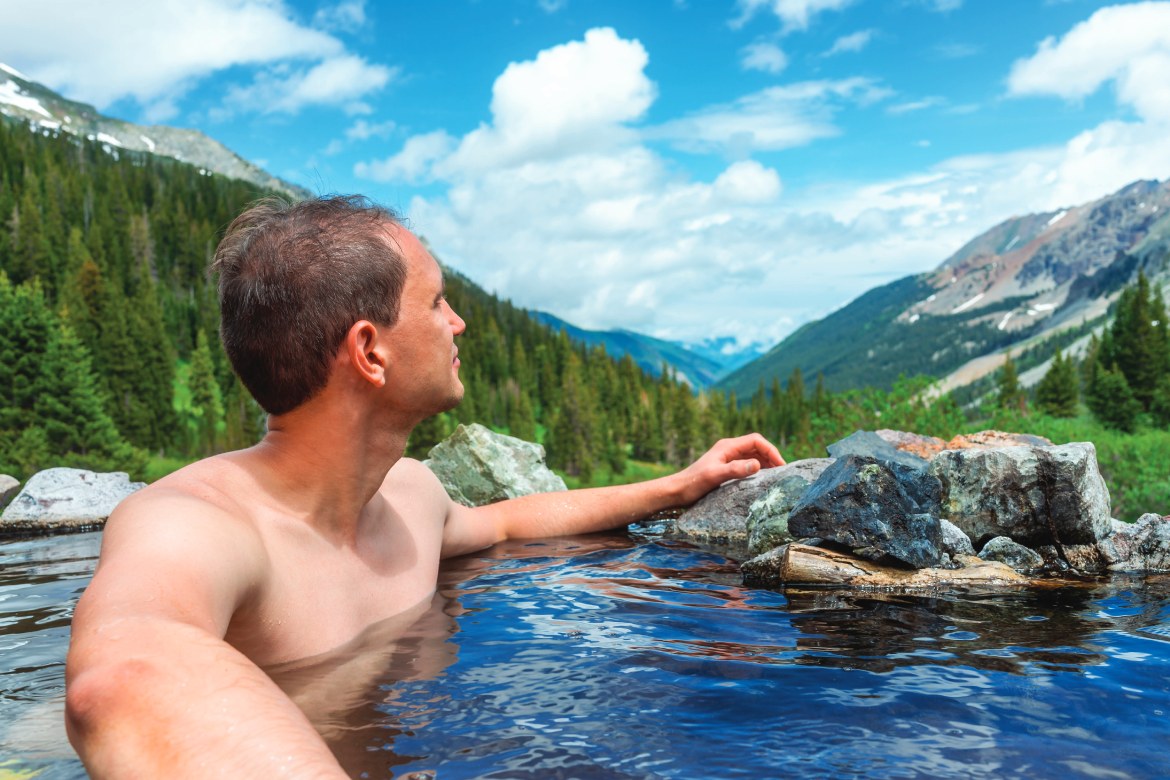Clothing-optional Orvis is one among a surplus of local springs worth splashing around in. Instead of a town square, Ouray boasts a town soak: a sprawling public complex of outdoor pools fed by geothermally heated water.
When I was a fifth grader in suburban Philadelphia, my favorite winter sport was dunking marshmallows in hot chocolate. The cocoa-scented steam left a patch of fog on the kitchen window into which I’d fingerpaint squeaky penises, then peer through their outlines, watching my brother and his friends strive to injure each other with hard-packed snowballs.
You can imagine the shivery chagrin with which I greeted my parents’ insistence that I take part in a school ski trip. “You really need to spend more time outside,” insisted my father, undoubtedly referring to both the house and my head.
“It’s an opportunity to socialize,” offered my mother, not recognizing my generalized pre-rainbow pride in pariahdom.
Spring Mountain, a hill, at best, was less than an hour’s yellow bus ride away, in slightly suburbaner Philadelphia. After an obligatory, perfunctory beginners’ group lesson, I rode the lift, slap-stepped my way to the balding summit, looked downhill with a pessimistic head shake and pushed off with my poles. Approximately three seconds and a dozen feet later, I face planted into a thin layer of mud-streaked slush. Twisting onto my side, skis awkwardly crossed, I realized it had begun to snow.
Craning my head a bit further, I grimaced, understanding that I’d stumbled into a particularly miniature blizzard, the winter precipitation equivalent of a personal pan pizza. It emanated from the snow-making cannon I now lay beside, quickly crusting my puffy vest and wet jeans in a layer of ice.
My classmates whizzed past, glancing and guffawing. Only after seven minutes of spastic detangling did I right myself. I shook off my shame, turned in my gear and marched toward the snack bar, resolving that the remainder of my life would be one long après ski.
THE WILD, WILD WET
Over the course of more than four decades I kept my vow to stay off the slopes. When planning vacations, snowy winter wonderlands were never considered. While some of my friends evolved from their own nerdy, sports-avoidant younger selves to discover the adrenaline rush and fetish adjacent wardrobe opportunities offered by gay ski weeks, I maintained a stubborn resolve.
Then last year, I came up with a creative new way to indulge my willful contrarianism. As it turns out, the San Juan Mountains in Western Colorado, known for ski resorts including Telluride, Silverton Mountain, and Purgatory, are also home to a wealth of geothermal springs.
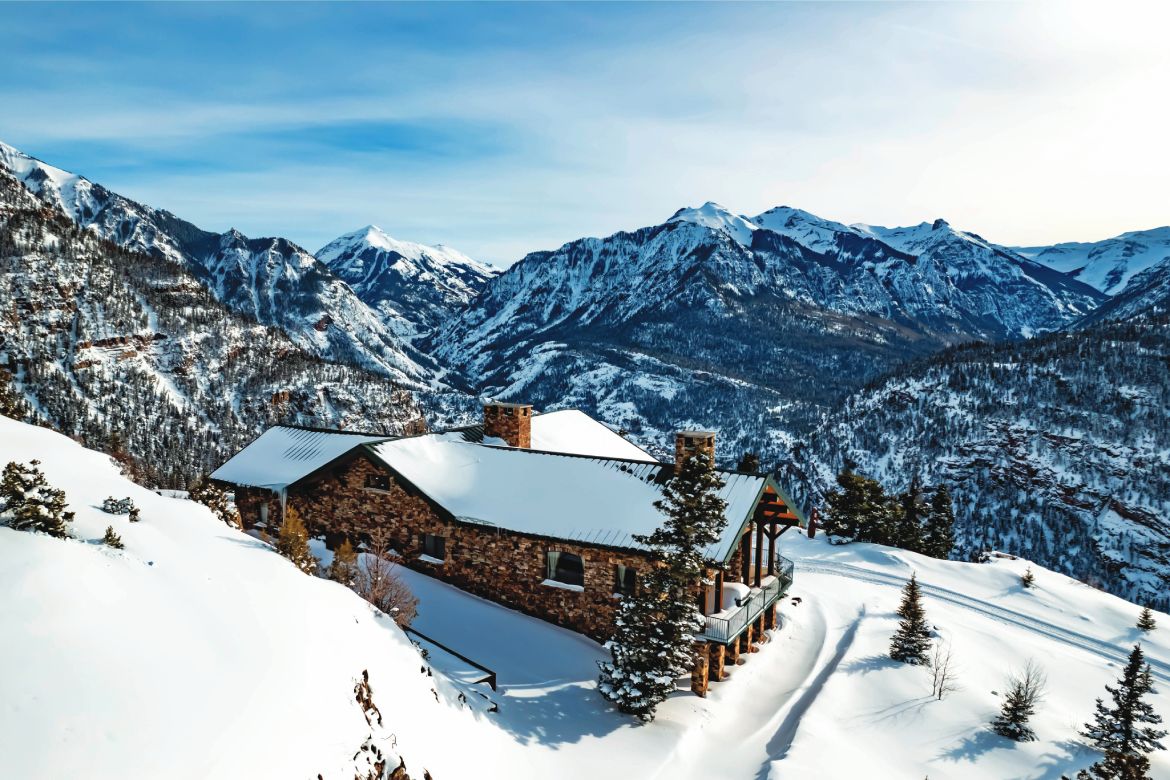
Wintertime in the San Juan Mountains (Photo by Joel Clouse)
The plate tectonics that created the mountain range between 18 and 40 million years ago left hot volcanic rock deep below the surface of the planet. Today, after water from snow melt and rain seep slowly downward through earth’s porous upper layers, it meets this super-heated material and turns to energized steam which surges upward, then transforms back to hot water before emerging at temperatures of 100 degrees Fahrenheit and higher and creating natural pools or being piped into man-made ones. With perverse glee, I would continue to avoid the slopes while literally plunging into ski country.
There’s a surreal sexiness to standing outdoors beneath snowcapped mountains wearing only a goosebump bodysuit. Clothing is optional at Orvis Hot Springs in Ridgway, Colorado (orvishotsprings.com) where my partner John and I spent a lazy afternoon ambling between several rustically landscaped pools.
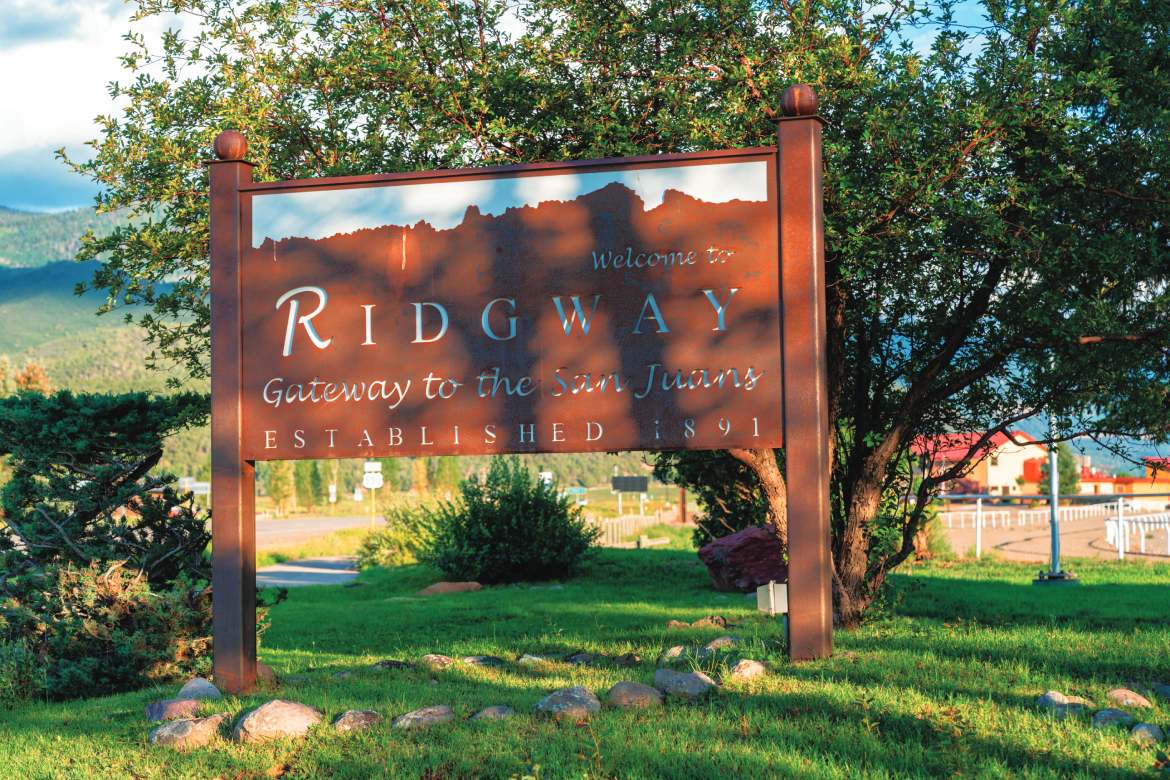
Welcome to Ridgway (Photo by Melissamn)
We’d flown into nearby Montrose airport, which due to its proximity to popular ski resort town Telluride (about 70 miles southwest), welcomes non-stop flights from cities including San Francisco, Boston, Chicago, Houston, and Dallas.
The largest pool at Orvis (40 feet wide and a maximum five feet deep) has the appearance of a rock-walled pond. It’s fed by small springs beneath its pebbled bottom; so, as you float your way from bank to bank or enjoy a submarine stroll, you’ll encounter several areas that are markedly warmer than the rest of the pool. It’s kept at approximately 103 degrees through the addition of cold water when needed.
Guests tend to cluster in pairs and small groups around the perimeter, chatting or floating quietly in the sun (be mindful and wear sunscreen, neither cold nor cloud cover blocks UV rays).
One of the smaller pools has been deemed a silent space and makes a fine spot for deep thought or meditation while taking in a view of Mount Sneffels, one of the San Juans’ highest peaks at over 14,000 feet. It’s also where you can enjoy a Japanese watsu treatment (water bound shiatsu massage) by appointment. More conventional massages are also offered in a yurt-like structures on the property.
While popular with queer locals and tourists, this is by no means an overtly cruisy environment. It’s a relaxing, contemplative oasis, welcoming all genders and ages, and it spells out some clear cut rules of etiquette: “If two people complain about someone being aggressive in ways such as staring, drooling, being invasive, etc., that person will be asked to leave permanently.” So: Swimsuits are optional, but don’t even think about wearing a bib.
OUT WEST
Observing appropriate drool-free decorum, two of the local queer community’s biggest boosters met in the waters of Orvis in 2021 and married not long after.
Rick Isenberg, a Scottsdale Arizona-based physician and therapist was amidst a period of self-examination when he headed out on a solo Colorado road trip and ended up at Orvis. While some might have been hesitant to wade into conversation with a naked stranger, seasoned traveler Isenberg had few qualms.
Back in 2013, Isenberg was on a Sierra Club- sponsored trip to the Canadian Arctic when his campsite was violently attacked by a polar bear. Isenberg helped a mauled fellow camper cling to life for hours as they awaited a Medevac helicopter rescue.
At Orvis, he was undaunted approaching a much friendlier bear by the name of Nick Coman who grew up queer and quiet in Ridgway and learned to sew under the tutelage of two grandmothers. He left his hometown, with its population of just over 1200, to attend the Fashion Institute of Design and Merchandising in Los Angeles.
LA remained Coman’s base for decades as he developed a successful career as a Hollywood costumer, fabric designer, and patternmaker, traveling nationally and internationally to teach workshops and give demonstrations.
On returning to Colorado to be close to his aging mother, Coman helped spearhead outreach and visibility efforts for the LGBTQ+ community in Ridgway (ridgwaycolorado.com) and the neighboring town of Ouray, pop. 923 (visitouray.com).
His Dragonfly Creative fiber arts studio (dragonflycreative.art) simultaneously serves as a personal design atelier, a classroom for workshops in sewing, weaving, and fashion design, and a drop-in center for local queer youth who need an ear, a safe space to hang, or to borrow a book from Coman’s collection of informative and empowering LGBTQ+ titles.
A similar library and center of support can be found at Mountain Dog Arts (mtndogarts.com), a pottery studio founded and operated by Jen Sawyer, a queer former U.S. Army attorney.
“When I left the service in 2018,” recalled Sawyer, “I bought an RV and was planning to be a nomad for a few years, leaving my stressful job behind and taking time to see the country, but after roaming for months, I found myself here in the San Juans and felt like this was where I belonged.”
While Sawyer still takes several long outdoor adventure trips each year, she’s made a home for herself in Ouray and Mountain Dog into a hang-out and home-away-from home for members of the local queer community. She also served as the officiant for Rick Isenberg and Nick Coman’s wedding.
A rainbow flag flies proudly outside of Mountain Dog Arts and stickers showing support for LGBTQ rights are affixed to many of the quaint storefronts along these towns’ main thoroughfares.
“Some people might be surprised to realize how many people live in relatively remote areas of the country like this identify as queer,” observed Isenberg, whose therapy practice serves many LGBTQ+ clients.
“For young people, it can feel more isolating than living in a big city so having a sense of community and support is especially important.”
Just a few phone calls from Sawyer led to nearly 20 queer locals and allies showing up at Mountain Dog at 7:30 A.M. on a weekday for coffee, donuts, and a chat with a certain snowmophobic gay journalist who was passing through. One high school senior, who had recently begun identifying as non-binary, came accompanied by their mother.
“Our graduating class has only 14 kids,” they noted, pointedly adding, “More than half of them identify as queer.” While that surprising figure may shift as the Class of ’23 grows up, it says much about new generations’ open-mindedness, even in a small rural town.
It also reflects an attitude that Sawyer and Coman consider far more emblematic of their state than the tragic 2022 shooting at Club Q in Colorado Springs. In 2018 and 2022, Coloradans elected and then re-elected the United States’ first openly gay governor, Jared Polis. And since 2021, tiny Ouray County (home to both Ridgway and Ouray), where approximately 40% of voters are registered Republican and 60% Democrat, has hosted a government-endorsed Pride parade and festival each June.
IT MIGHT AS WELL BE SPRINGS
As nearby Telluride has become more expensive and exclusive over the years, Ridgway and Ouray have grown in popularity. Both offer an easy drive to and from their more famous neighbor’s justifiably acclaimed slopes (if you care about that sort of thing), while boasting lower accommodation prices and plenty of their own more rustic appeal.
Clothing-optional Orvis is one among a surplus of local springs worth splashing around in. Instead of a town square, Ouray boasts a town soak: a sprawling public complex of outdoor pools fed by geothermally heated water (ourayhotsprings.com).
With adults-only areas for quiet chilling (or warming, in this case), all-ages zones featuring impressively tortuous slides, water volleyball, a climbing wall, and full shower and changing facilities, the pools are not just a tourist attraction. They’re a year-round hub of local life offering a steamy sense of freedom when winter temperatures drop well below freezing in the winter months. Up until 10 P.M., you’ll find Coloradan neighbors catching up with each other in this surprisingly sociable setting as mist rises around the topaz-bottomed pools.
John and I spent a cozy January night at Ouray’s Twin Peaks Lodge and Spa (twinpeakslodging.com), which has its own private hot springs complex. Day passes can be purchased, but after 7 P.M. the grounds are open to lodge guests only for swimming and soaking under the stars.
As we grinned in the moonlight, lolling in the uppermost of three tiered stone tubs, fat snowflakes drifted down, frosting the nearby pines, and adding an extra bit of shimmer to the alpine landscape that surrounds this town, which proudly refers to itself as “The Switzerland of America.”
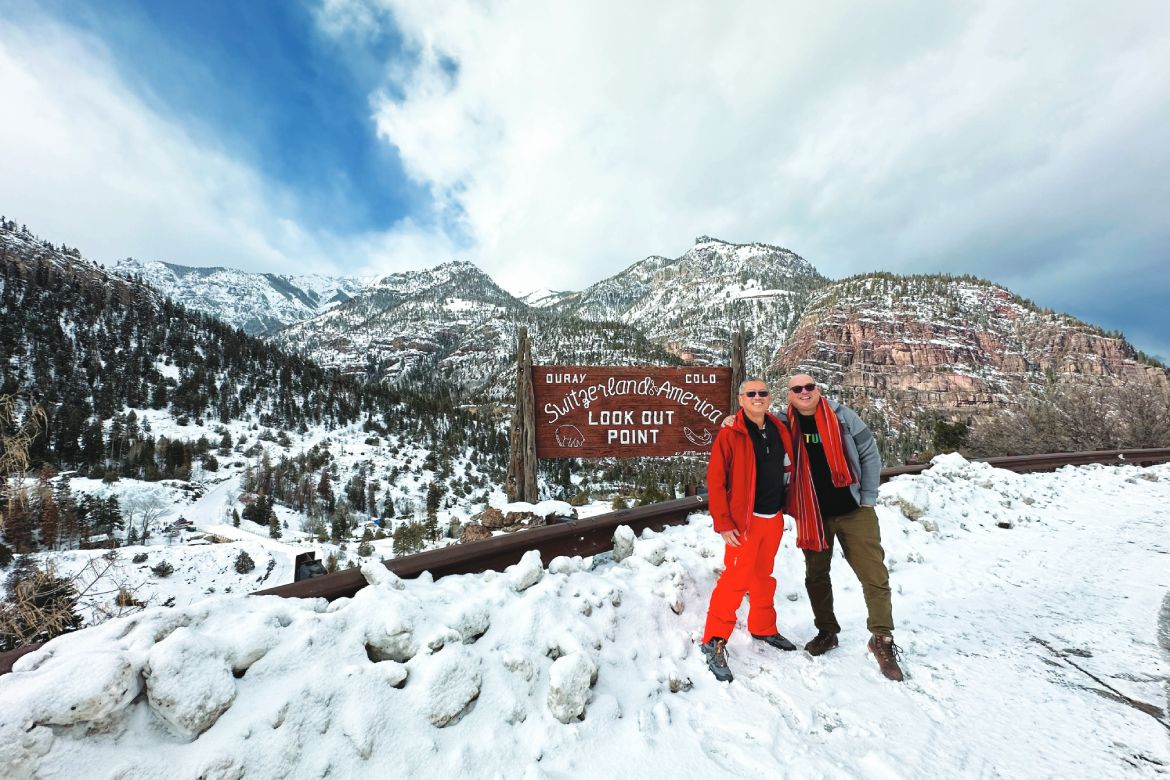
Jim and John in Ouray Colorado, the “Switzerland of America” (Photo by Jim Gladstone)
Among Ouray’s other accommodations with private springs is the Box Canyon Lodge, featuring seven red cedarwood soaking tubs reserved exclusively for guests (boxcanyonouray.com).
The historic Wiesbaden Lodge (wiesbadenhotsprings.com) dates to 1879, when it was known as Mother Buchanan’s Bath House and frequented by scruffy bachelor silver miners in need of a good scrub. In the 1920s, the property was purchased and rechristened as Dr. C.V. Bates’Hospital and Sanitarium, where it was claimed that the spring waters were a miraculous arthritis cure. Today, the charming main lodge and adjacent rental cottages still welcome guests to visit their vapor caves: naturally heated, and slightly spooky, subterranean steam rooms.
A few miles west in Ridgway, the funky timber and adobe Chipeta Lodge (aka The Chia Pet. chipetalodge.com) makes up for the lack of underground springs on its property with a bodacious second-story outdoor Roman bath offering panoramic mountain views. Some of its timbered guest rooms feature private hot tubs, and the in-house spa has a rugged sweat-lodge style steam room.
SMALL-TOWN CULTURE
After bathing, steaming, and getting massaged until you’ve thoroughly softened your skin, mellowed your mood, and turned your digits into happy little prunes, it’s well worth exploring a bit of the local history.
Several celebrated Hollywood movie westerns were filmed in the area. With a little research, you can visit the meadow where Robert Preston and Debbie Reynolds’ characters got engaged in How the West Was Won; John Wayne donned an eyepatch to play Rooster Cogburn in True Grit; and James Cagney shot his last western, Tribute to a Bad Man, directed by Robert Wise, who later made West Side Story.
Ridgway has a small Railroad Museum (ridgwayrailroadmuseum.com) that memorializes the death defying engineering that allowed supplies to get in and out of local mining camps. And in Ouray, the Ranch History Museum (wocrhm.org) showcases artifacts reflecting the day to day lives of the area’s farming and cattle-raising families between 1880 and the present.
The 126-year-old Wright Opera House in Ouray (thewrightoperahouse.org) is a classic western theater with wrought iron exterior ornamentation and a vaulted auditorium that is worth a visit not just for its lovingly restored architecture and design, but for an array of community programming.
Letitia Wright, the outspoken wife of a 19th Century developer, was concerned with the drinking and dance hall antics indulged in by the local mining community and pushed her husband to build the hall to provide more edifying cultural offerings.
Today there’s a robust schedule of film screenings, concerts, and theatrical productions. John and I dropped in on an impressively well-attended poetry reading at which local iconoclast Art Goodtimes, a long-bearded former newspaper editor and social activist, held forth extolling the gospel of full-spirited crunchy granola mountain living.
A similar patchwork of entertaining and educational programs is offered at Ridgway’s Sherbino Theater (sherbino.org), a regular stop for nationally touring folk, country, and Americana musicians
Dining options in these hospitable twin towns run toward hearty simple fare, but it’s frequently marked by quality and creativity. Ridgway’s GNAR Tacos (gnarlytacos.com) for instance, where we hung out with the gay newlyweds, Rick and Nick, has a riotously graffitied interior and a manifesto that asserts its maintenance of “a high scale of coolness, radicalness, and nonconformity.” The Lambrizo taco with house made lamb sausage, pineapple salsa, and coconut curry aioli, brought summertime vibes to a winter’s night. And the Yardcore, piled high with chicken thighs, tater tots, cheese, and spicy “Rick Ross Sauce” was a ridiculous bargain at $5.

Tacos at GNAR Tacos (Photo by From My Point of View)
Colorado Boy (coloradoboy.com), which has outposts in both Ridgway and Ouray, brews its own beers and serves baked-to-order pizzas that keep its pubs crowded with chatty locals year round. We washed down a Honey Pie (capicola, spicy honey, garlic, red pepper flakes) with a robust Irish Red Ale from the tap.
Kami’s Samis (kamissamis.com) serves up huge breakfast burritos as well as overstuffed sandwiches to pack for lunch while out on one of Ouray’s many well-marked hiking trails.
GOOD SPORTS
The stunning surroundings of the southern Rockies inspired even this cocoa-slurping urban aesthete to go beyond bobbing in hot springs like a human marshmallow and engage in a bit of the manly winter sporting I’d long forsaken.
John and I pulled on our boots to follow the snow-dusted paths around two spectacular frozen waterfalls, Box Canyon Falls and multi-tiered Cascade Falls which step sits way hundreds of feet down jagged rock walls. As we marveled at the icy cataracts, a family of deer trotted by.
We vowed to come back one summer after the suspended animation has ended, the falls have started to fall again, and the pools below them fill with waders seeking relief from heat that’s hard to imagine in January.
While downhill slaloms remained out of the question as far as I was concerned, Kailey Rhoten, a Colorado native who cultivates Ouray tourism, convinced me that the best way to experience Ironton, an abandoned mining town 8 miles south, was on cross-country skis.
Only about 10 of the approximately 300 small wooden buildings constructed in Ironton in the 1880s and 1890s still stand. In its heyday the town was a hub in the supply chain that brought supplies to silver miners in the mountains, but the precious veins were depleted in the early 20th century and, lacking any viable industry, the town was gradually abandoned.
Today, well-maintained Nordic ski trails loop through the spooky shells of this long-gone industrial village. Even this total amateur, who’d not been on skis for decades, found pushing poles and gliding through the ghost town not only manageable, but pleasurable.
For 90 minutes only bird calls, heavy breath, and the quiet whoosh of our strides against the snowpack broke the vast bleached silence. I realized that skiing, at least the cross-country variety, could be meditative, not merely athletic. I was certainly impressed with myself for letting down my guard enough to glide through the ghost town, but Ouray’s truly impressive athletic feats aren’t accomplished on skis.
Beyond its steamy springs, the town is also internationally known for the Ouray Ice Park (ourayicepark.com), the world’s largest man-made ice climbing facility. An astonishing confluence of nature and human engineering, the park sidles along both sides of two mile gorge on the Uncompahgre River. Each November, as temperatures dip below freezing, overflow water from the city’s spring-fed supply is piped to the gorge and sprayed down the canyon walls through 250 strategically placed sprinklers, freezing into a dramatic icescape.
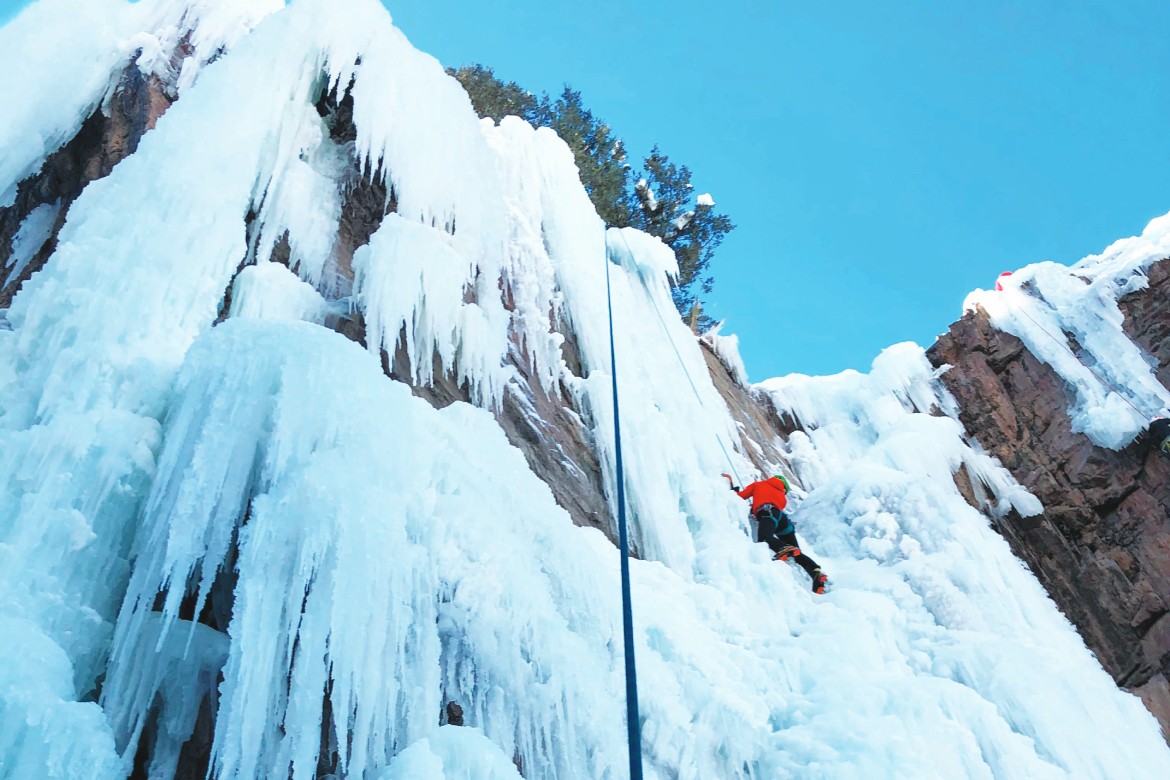
Ouray Ice Park (Photo by shu2260)
Each night during the park’s open season, over 150,000 gallons of additional water are sprayed on to strengthen and reinforce the precipitous frozen walls—over three square miles of vertical surfaces.
Throughout the winter, the park is a challenging playground for serious climbers. Equipped with sharp-spiked crampons, ice axes, belaying ropes, and other tools of this treacherous recreation, these helmeted wall warriors flock to Ouray from around the world to test their skills.
On a lark, John and I took a quick lesson on a short, protected kiddie wall (instructions, guides, and gear rental can be reserved online or found on site), but for all but the most intrepid vacationers, this is a spectator sport, the stuff of National Geographic films and daredevil documentaries.
In late January each year the park becomes a global ice climbing mecca with a major international competition, and the town fills with curious tourists eager to check out the spectacle. In addition to watching climbs live and at the weekend’s film screenings, classes and clinics are also available for aspiring climbers and curious novices.
In 2022, the park, which operates as a public, non-profit institution, initiated its annual All In Ice Fest (allinicefest.com), specifically developed to open the sport of ice climbing to BIPOC, LGBTQ+, and differently abled participants.
Unbeknownst to John and me, our visit coincided with the initial All In events. We anxiously observed an indefatigable athlete as he painstakingly clambered up a wall, his body practically perpendicular to the ice. Only afterward did we learn that this climber was blind.
DRIVING ME CRAZY
The intensity of my aversion to downhill skiing is easily equaled by my partner John’s passion for high-thrill driving. So he was thrilled about the ride from tiny Ouray to Durango, which is almost 20 times as large (but still small, with a population around 19,000)—a stretch of U.S. 550 that’s known as the Million Dollar Highway. The exact source of that nickname is unclear, but one theory is that in 1920, each of its 25 miles cost $1 million to construct (about $400 million total in today’s dollars).
Taking a serpentine path from Ouray’s altitude of 8000 feet up to a height of over 11,000 feet through Red Rock Pass, this is beyond a doubt one of the country’s most remarkable scenic routes, in the league of Kentucky’s Blue Ridge Parkway and the Pacific Coast Highway.
John grinned maniacally while I gritted my teeth and clutched white-knuckled fists as he traced the road’s sharp curves and I gaped at the precipitous drops just beyond my passenger window. Snow-covered peaks thrust above us, and deep ravines opened below. There were occasional daredevil skiers to be sighted, but in general the terrain was too rough and too steep for sporting.
While it had snowed the night before our drive, Colorado has an impressive expertise at plowing its major thoroughfares and the roads were remarkably clear. Still, the panoramic beauty here must be navigated with an abundance of caution. There are points at which the road’s two lanes narrow to such a degree that even imagining an 18-wheeler approaching from the other direction is enough to induce nausea. “Yeeeha!” shouted John, an abominable snow pig in shit. I winced in terror. Still, he took a lovingly circumspect 90 minutes to go the distance.
After reaching the route’s terminus near the small town of Silverton, we continued toward Durango, stopping just outside the city for a tour of the James Ranch (jamesranch.net), a family-owned center for regenerative agriculture. The ranch’s Red Angus cattle are grass-fed and never treated with hormones or antibiotics; their beef is sold only to local restaurants and markets, and to the public at a store on ranch property.

Silverton, Colorado (Photo by Jeremy Janus)
In spring and early summer, visitors can observe the hands-on, unmechanized production of three artisanal cheeses made with milk from the herd’s cows. Their signature Reserve Belford is aged for three years, resulting in a butterscotchy, Gouda-like flavor and an interior flecked with crystals.
Like James Ranch’s beef, its cheeses, fruits, and vegetables rarely leave a 50 mile radius. Luckily, travelers are welcome to tuck into a hyper-local meal at the casual grill restaurant where, during the winter months, one can settle in by the fireplace and gaze out on snow-dusted red rock cliffs through floor-to-ceiling picture windows. Put an ear to your cheeseburger and it may whisper “There’s no place like home.”
ON TO DURANGO
Durango (durango.org) residents, officially called Duranguese, though I prefer Durangutans, will proudly tell you that theirs is a ski town and college town. With the famous Purgatory ski resort just a short drive from the town center and Fort Lewis College right in the middle of it, Durango indeed exudes a laid back but freewheeling party vibe: neo-hippie meets North Face with legal marijuana dispensaries a stone’s throw in any direction.
Like Boulder a few hours east, Durango is a hotbed of Colorado progressivism. So, it felt completely natural that a few miles from city hall, at a spot off the highway where another middle-American city might have a multiplex or strip mall, Durango’s populace flocks to a gigantic outdoor hot springs park.
The Durango Hot Springs Resort and Spa (durangohotspringsresortandspa.com), once known as the Trimble Hot Springs, has a rich history as a leisure destination with hotels, rodeo grounds, and other diversions complementing the waters. In 1949, Clark Gable stayed here while filming Across the Wide Missouri.
In its current incarnation, the outdoor resort feels like a lively local social club. Durango friends and neighbors with seasonal passes are as much a presence as tourists, who pay $40 for two and a half hours’ access to a naturally heated central swimming pool surrounded by over 30 soaking areas, including Japanese cedar hot tubs that are available by private reservation.
Open until 10 P.M. with bars serving wine and beer, the resort is particularly appealing after sundown when skiers flock to the waters to revive sore muscles and visitors from less geologically blessed locales indulge in the mist-veiled pleasures of al fresco bathing.
After a hot tub happy hour gazing out at the light speckled southern Rockies, John and I headed back to town and checked into the centrally located Rochester Hotel (rochesterhotel.com) and then walked a few blocks for dinner at one of Durango’s most celebrated restaurants the Ore House (orehouserestaurant.com), a handsome steak-forward saloon that provided an ideal setting for the last big meal of our western Colorado adventure.
Joining us for deluxe wedge salads with juicy pork belly in lieu of crumbled bacon, 35-day aged Delmonico rib eyes, and perfectly mixed negronis and Old Fashions, was genderfluid local entrepreneur Lazarus Omni, the founder of Omni Bagels (omnibagels.com).
While the dark, wood-paneled Ore House is imbued with nostalgia for the Old West, Omni Bagels ticks pretty much all the boxes for a Gen Z-driven Durango-fangled business: It’s woman/queer owned and operated, incorporates ingredients from local sustainable producers, takes online orders and offers subscriptions, uses only compostable packaging, collaborates with over a dozen non-profit partners, and goes beyond bagels (in non-New Yorky flavors like Japanese Sesame, Apricot Habanero, and Pineapple Curry), to also bake dog treats. “The amount of support we’ve gotten from the local community is fantastic,” says Omni.
Seconding Omni’s endorsement of Durango as an open-minded and forward-leaning town is Jake Riggs, a local event promoter and entertainer perhaps better known as his drag persona, Aria Petty One (facebook.com/AriaPettyOne), a green-skinned alien seductress who could be the lovechild of Wicked’s Elphaba and Ziggy Stardust .
Originally from Baltimore, Riggs says he’s discovered that “you might not expect to be able to live an openly queer life outside of a big city, but I love it here.” Riggs, who performs statewide (past gigs have extended from Denver nightspots to the Ouray County Pride festival), says that while it would be hard for a bar or club focused strictly on queer clientele to survive in a town of only 20,000 people like Durango, local businesses have nonetheless embraced the LGBTQ+ community and its supporters.
Regularly scheduled drag shows at venues including the Starlight Lounge (instagram.com/loungestarlight), Father’s Daughters Pizza (fathersdaughterspizza.com), and 11th Street Station (11ststation.com), draw notably heterogeneous audiences, providing a sense of shared safety and sociability to all.
BLOWING OFF STEAM
For our final winter adventure in Western Colorado, John and I boarded a railroad car pulled by a vintage steam locomotive for a stunning 52 mile loop through the mountainous snowscape along the Animas River.
A National Historic Civil Engineering Landmark, The Durango-Silverton Narrow Gauge Railway (durangotrain.com), prominently featured in Butch Cassidy and the Sundance Kid, has magnificently restored and blessedly winterized coaches.
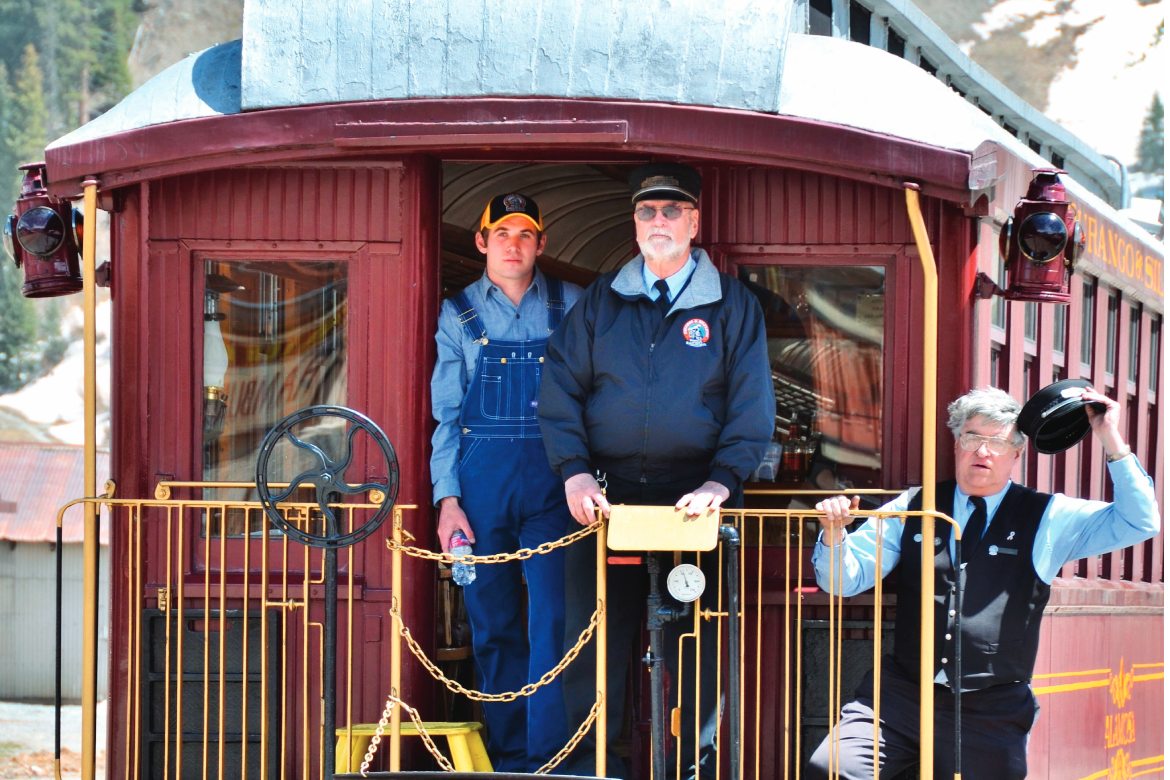
Durango & Silverton Narrow Gauge Railroad (Photo by Jim Lambert)
Sitting six cars back from the engineer, we could look out the window and see the puffing locomotive ahead of us as the train arced along deep curves of rail, high above Cascade Canyon.
John, who’d kept his eyes on the road through our drive to Durango, at last had his chance to take in an indelible scene of the American west: rock and river under blue skies and blankets of snow.
While sharing facts and folklore about the passing scenery, our lanky blond cabin attendant accidentally let slip that he was studying vocal music, at which point I asked if he’d be willing to give us a little serenade.
And so, forty-odd years after insecurely spying on boys through a foggy winter window, I sat with my partner sipping spiked hot cocoa, recalling favorite hot springs, and chugging along to a charming rendition of Nat King Cole’s “L-O-V-E.”
Childish thoughts and downhill skiing be damned. From this vantage point, everything was looking up.

